Don't wanna be here? Send us removal request.
Text
Introduction to 4Achievers - The Best Data Science Training Institute in Noida

What sets us apart from other institutes is our experienced and knowledgeable faculty who have years of experience in the industry. Our course curriculum is designed to cover all the important aspects of Data Science, including statistical analysis, machine learning, data visualization, and more.
Looking for the best Data Science training institute in Noida? Look no further than 4Achievers! We are a globally recognized institute that offers comprehensive and industry-relevant Data Science courses to help students become proficient in the field.
At 4Achievers, we believe in providing hands-on training to our students through real-world projects and case studies. This enables our students to get a practical understanding of the subject and apply their knowledge in real-life scenarios.

So, whether you are a student looking to start your career in Data Sciencee or a working professional looking to upskill, 4Achievers is the perfect institute for you. Contact us today to know more about our courses and start your journey towards a successful career in Data Science!
2. Experienced and Knowledgeable Faculty
3. Comprehensive Curriculum
5. 100% Placement, Internship, and Job Opportunities
We also offer 100% placement, internship, and job opportunities to our students. Our placement cell works tirelessly to help our students get placed in top companies in the industry.
4. Hands-On Training through Real-World Projects and Case Studies
6. Conclusion - Choose 4Achievers for Your Data Science Training Needs
We believe in providing our students with the best possible learning experience to help them become proficient in Data Science. Our courses are designed to cover all the important aspects of the subject and equip our students with the necessary skills to succeed in the industry.
In conclusion, if you are looking for a quality Data Science training institute in Noida, 4Achievers should be your top choice. Our comprehensive course curriculum, experienced faculty, practical training methods, and 100% placement assistance make us the best in the industry.
So, whether you are a student or a working professional, choose 4Achievers for your Data Science training needs and take the first step towards a successful career in this exciting field. Contact us today to know more about our courses and start your journey towards a brighter future. Link: https://www.4achievers.com/data-science-training-in-noida
Location C-58, Captain Vijyant Thapar Marg,C Block, Sector 2 Noida, Uttar Pradesh 201301 +91-801080-5667
We believe in providing
4Achievers for your Data Science training
Address 4Achievers- Noida
#DataScienceTraining#BestInstitute#Noida#4Achievers#ComprehensiveCourse#IndustryRelevant#ExperiencedFaculty#PracticalTraining#RealWorldProjects#CaseStudies#100%PlacementAssistance#QualityTraining#CareerGoals#PersonalizedSupport#Guidance#MachineLearning#DataVisualization#StatisticalAnalysis#Upskill#SuccessfulCareer
0 notes
Text
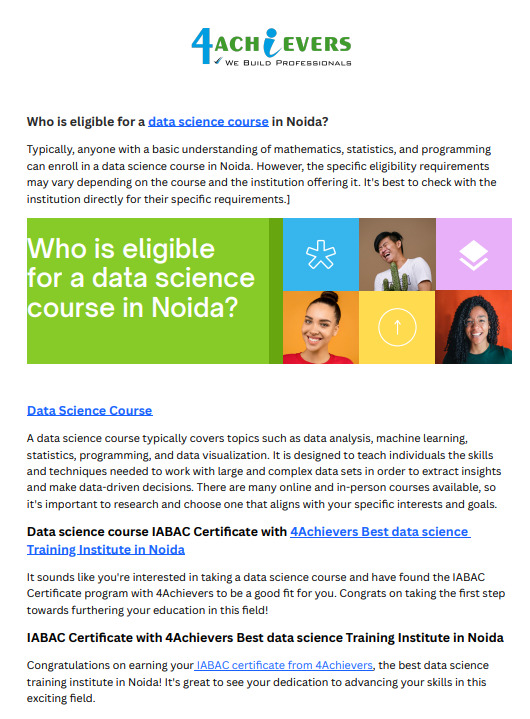
Who is eligible for a data science course in Noida?
Typically, anyone with a basic understanding of mathematics, statistics, and programming can enroll in a data science course in Noida. However, the specific eligibility requirements may vary depending on the course and the institution offering it. It's best to check with the institution directly for their specific requirements
#1.#datasciencecourse#2.#noidadatascience#3.#learnanalytics#4.#bigdatacourse#5.#dataminingtraining#6.#businessintelligence#7.#machinelearning#8.#artificialintelligence#9.#datasciencecertification#10.#datasciencetraining#11.#dataanalytics#12.#dataengineering#13.#datasciencejobs#14.#datasciencecareer#15.#datavisualization
0 notes
Text
Who is eligible for a data science course in Noida?
Typically, anyone with a basic understanding of mathematics, statistics, and programming can enroll in a data science course in Noida. However, the specific eligibility requirements may vary depending on the course and the institution offering it. It's best to check with the institution directly for their specific requirements.]
Data Science Course
A data science course typically covers topics such as data analysis, machine learning, statistics, programming, and data visualization. It is designed to teach individuals the skills and techniques needed to work with large and complex data sets in order to extract insights and make data-driven decisions. There are many online and in-person courses available, so it's important to research and choose one that aligns with your specific interests and goals.
Data science course IABAC Certificate with 4Achievers Best data science Training Institute in Noida
It sounds like you're interested in taking a data science course and have found the IABAC Certificate program with 4Achievers to be a good fit for you. Congrats on taking the first step towards furthering your education in this field!
IABAC Certificate with 4Achievers Best data science Training Institute in Noida
Congratulations on earning your IABAC certificate from 4Achievers, the best data science training institute in Noida! It's great to see your dedication to advancing your skills in this exciting field.
#data science#data engineers#data scientist#datasciencecareer#dataanalytics#datascientist#database#big data
0 notes
Text
What is the best AWS training institute in Noida?
1. What is the best AWS training institute in Noida?
Answer: 4Achievers is the best AWS training institute in Noida.
If you're looking to upskill yourself in the field of cloud computing, particularly in AWS, then 4Achievers in Noida is definitely worth checking out. Here are some reasons why it is considered the best training institute for AWS:
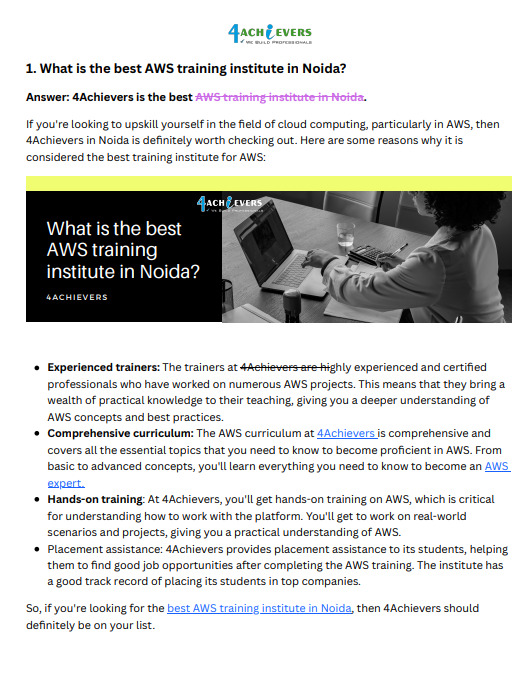
Experienced trainers: The trainers at 4Achievers are highly experienced and certified professionals who have worked on numerous AWS projects. This means that they bring a wealth of practical knowledge to their teaching, giving you a deeper understanding of AWS concepts and best practices.
Comprehensive curriculum: The AWS curriculum at 4Achievers is comprehensive and covers all the essential topics that you need to know to become proficient in AWS. From basic to advanced concepts, you'll learn everything you need to know to become an AWS expert.
Hands-on training: At 4Achievers, you'll get hands-on training on AWS, which is critical for understanding how to work with the platform. You'll get to work on real-world scenarios and projects, giving you a practical understanding of AWS.
Placement assistance: 4Achievers provides placement assistance to its students, helping them to find good job opportunities after completing the AWS training. The institute has a good track record of placing its students in top companies.
So, if you're looking for the best AWS training institute in Noida, then 4Achievers should definitely be on your list.
0 notes
Text

#softwaretesting#manualtesting#sdet#functionaltesting#programming#whatissoftwaretesting#automation#testing tools#testing#postman#bigdatatesting#etltesting#softwaretestingmaterial#softwaretestingtutorial#softwaretestingtraining#webservices#soapui#rest assured#hadooptesting#integrationtesting#software#manualtestingtutorial#softwaretestingtutorialforbeginnersseleniumvideos#performancetesting#automation testing#regressiontesting#softwaretestingforbeginners#softwaretestingtypes#testingtutorial#softwaretesting lifecycle
0 notes
Text

#softwaretesting#manualtesting#sdet#functionaltesting#programming#whatissoftwaretesting#automation#testing tools#testing#postman#bigdatatesting#etltesting#softwaretestingmaterial#softwaretestingtutorial#softwaretestingtraining#webservices#soapui#rest assured#hadooptesting#integrationtesting#software#manualtestingtutorial#softwaretestingtutorialforbeginnersseleniumvideos#performancetesting#automation testing#regressiontesting#softwaretestingforbeginners#softwaretestingtypes#testingtutorial#softwaretesting lifecycle
0 notes
Text
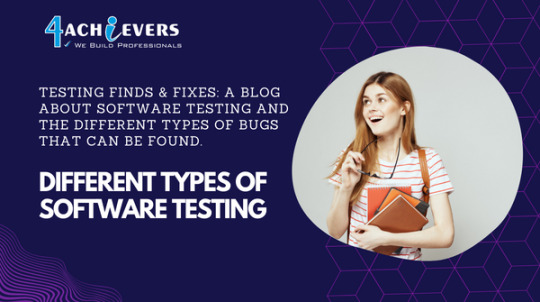
#softwaretesting#manualtesting#sdet#functionaltesting#programming#whatissoftwaretesting#automation#testing tools#testing#postman#bigdatatesting#etltesting#softwaretestingmaterial#softwaretestingtutorial#softwaretestingtraining#webservices#soapui#rest assured#hadooptesting#integrationtesting#software#manualtestingtutorial#softwaretestingtutorialforbeginnersseleniumvideos#performancetesting#automation testing#regressiontesting#softwaretestingforbeginners#softwaretestingtypes#testingtutorial#softwaretesting lifecycle
0 notes
Text
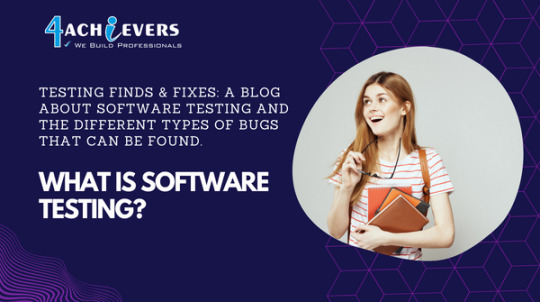
#softwaretesting#manualtesting#sdet#functionaltesting#programming#whatissoftwaretesting#automation#testing tools#testing#postman#bigdatatesting#etltesting#softwaretestingmaterial#softwaretestingtutorial#softwaretestingtraining#webservices#soapui#rest assured#hadooptesting#integrationtesting#software#manualtestingtutorial#softwaretestingtutorialforbeginnersseleniumvideos#performancetesting#automation testing#regressiontesting#softwaretestingforbeginners#softwaretestingtypes#testingtutorial#softwaretesting lifecycle
0 notes
Text
Testing Finds & Fixes: A blog about software testing and the different types of bugs that can be found.
Testing Finds & Fixes: A blog about software testing and the different types of bugs that can be found.
Welcome to Testing Finds & Fixes! This blog is all about software testing and the different types of bugs that can be found. We'll talk about everything from regression testing to smoke testing, and we'll discuss how to find and fix those pesky bugs. So whether you're a software developer or a tester, this blog is for you. So sit back, relax, and enjoy!

What is software testing?
Software testing is the process of verifying the functionality of a software program. Testing can be done manually or automatically. Manual testing typically involves running the software program and trying out various inputs to see if the output is as expected. Automated testing involves writing code that will test the software program automatically. There are different types of software bugs that can be found during testing. These include syntax errors, logical errors, and runtime errors. Syntax errors are usually easy to fix and can be found by compilers. Logical errors are more difficult to find and may require manual testing. Runtime errors can cause the software program to crash and can be difficult to debug.
Different types of software testing
Different types of software testing can be used to find and fix different types of bugs. Functional testing is a type of testing that checks the functionality of the software. This type of testing can be used to find bugs in the software's functionality. Unit testing is a type of testing that checks the individual units of code in the software. This type of testing can be used to find bugs in the software's code. Integration testing is a type of testing that checks how different units of code work together. This type of testing can be used to find bugs in the way the software's code integrates with other code. System testing is a type of testing that checks the entire system, including all units of code and all dependencies. This type of testing can be used to find bugs in the way the system works as a whole.
How to find and fix bugs
Bugs are inevitable when it comes to software development. No matter how much effort is put into the testing process, there will always be some defects that make it through to the final product. The key is to find and fix as many bugs as possible before the software is released to users. There are a number of different ways to find bugs in software. One of the most important methods is code review. This is where experienced developers go through the code line by line to look for potential issues. Another common method is static analysis, which uses automated tools to scan the code for potential problems. Once bugs have been found, they need to be fixed. The first step is to identify the root cause of the problem. Once the cause has been identified, a fix can be implemented and tested to ensure that it works as intended. In some cases, it may be necessary to patch the software in order to provide a quick fix for users while a more permanent solution is developed.
Tips for fixing different types of bugs
There are a few different types of bugs that can be found when testing software. Here are some tips for fixing each type: 1. Syntax errors – These are usually easy to fix, as they’re simply due to incorrect code. Check your code against the original source to make sure it’s correct, and then fix any mistakes. 2. Logical errors – These can be trickier to track down, as they’re often caused by incorrect assumptions about how the code works. Test thoroughly and look at error logs to try and identify where the problem lies. Once you know where the error is, you can start working on a fix. 3. Interface errors – If there are problems with how the interface looks or works, it may be due to incorrect markup or CSS. Again, check your code against the original source to find any mistakes and then fix them. 4. Performance issues – Slow loading times or other performance problems can be caused by a number of factors, including bad code, overloaded servers, or insufficient resources. Try to identify the cause of the problem and then work on fixing it. 5. Security vulnerabilities – These types of bugs can be serious, as they can leave systems open to attack. If you find a security vulnerability, report it immediately so that it can be fixed as soon as possible.

What is software testing?
Different types of software testing can be used to find different types of bugs. For example, unit testing is a type of software testing that helps to find and fix errors in individual units of code, like classes and methods. Integration testing is another type of software testing that helps to find and fix errors that occur when different units of code are combined. And regression testing is a type of software testing that helps to find and fix errors that reoccur after changes have been made to the code.
The different types of software testing
There are many different types of software testing, each with its own strengths and weaknesses. Here are some of the most common: 1. Unit Testing Unit testing is the most basic form of software testing, and involves testing individual units of code (known as "modules") to ensure they work as expected. This is usually done by the developers themselves, before the code is integrated into the larger system. 2. Integration Testing Integration testing is a step up from unit testing, and involves testing how different modules work together. This is important to ensure that there are no conflicts or errors when the code is integrated into the final product. 3. System Testing System testing is a comprehensive type of testing that covers all aspects of the system, including performance, security, usability, etc. This is usually done by independent testers, after the code has been fully integrated. 4. User Acceptance Testing (UAT) User acceptance testing (UAT) is the final stage of testing before a system is released to users. In this type of test, actual users are brought in to try out the system and provide feedback on its usefulness and user-friendliness. UAT is important to ensure that the system meets the needs of its intended users before it's released publicly.
The different types of bugs that can be found during software testing
There are many different types of software bugs that can be found during testing. Some of the most common include: Syntax errors: These are usually the easiest to find and fix, as they will typically result in the code not compiling or running at all. Logic errors: These can be more difficult to find, as they may only result in incorrect results or unexpected behavior. Interface errors: These occur when there is an issue with how the software interacts with other software or hardware components. Performance issues: These can manifest as either slow performance or unexpected crashes. Security vulnerabilities: These can allow attackers to gain access to data or systems that they should not have access to.

How to fix bugs that are found during software testing
When a software tester finds a bug, it is important to report it to the development team so that they can fix it. There are many ways to do this, but here are some tips on how to fix bugs that are found during software testing: 1. Make sure you have all the information about the bug before you report it. This includes things like what steps you took to reproduce the bug, what happened when the bug occurred, and any other relevant details. The more information you can provide, the easier it will be for the developers to find and fix the bug. 2. Be as specific as possible when describing the bug. Again, this will help the developers track down and fix the issue faster. If you can narrow down which part of the code is causing the problem, that’s even better. 3. If possible, try to provide a suggested solution for fixing the bug. This isn’t always possible, but if you have an idea of how to fix it, that can be very helpful for the development team. 4. Finally, remember that developers are human too! They want to fix bugs just as much as you want them fixed. So don’t be afraid to report them – they’ll appreciate it in the end!
Different types of software testing
There are many different types of software testing, each with its own strengths and weaknesses. Here are some of the most common: 1. Unit Testing: Unit testing is the most basic form of testing, and involves testing individual units of code (usually individual functions or methods) to ensure they work as expected. This is typically done by the developer who wrote the code, using a unit test framework. 2. Integration Testing: Integration testing is a step up from unit testing, and involves testing how different units of code work together. This is often done by creating small tests that exercise the interfaces between different components. 3. Functional Testing: Functional testing goes one step further than integration testing, and tests how the system works as a whole, from the user's perspective. This usually involves manually executing various scenarios and checking that the system behaves as expected. 4. Performance Testing: Performance testing is concerned with how well the system performs under load. This can involve stress testing (running the system with a very high load) or benchmarks (measuring specific metrics such as response time or throughput). 5. Security Testing: Security testing focuses on ensuring that the system is secure against potential attacks. This can involve fuzzing ( feeding random data to the system in an attempt to break it) or penetration testing (simulating an attack in order to assess the security of the system).
How to find and fix bugs
When it comes to software testing, one of the most important aspects is finding and fixing bugs. There are many different types of bugs that can be found in software, and it is important to know how to find and fix them. One type of bug is a syntax error. This is when there is a mistake in the code itself, and it will not compile. Syntax errors can be fixed by simply correcting the code. Another type of bug is a logical error. This is when the code compiles but does not produce the desired results. Logical errors can be more difficult to find and fix, as they often require tracing through the code to find where the problem lies. A third type of bug is an algorithm error. This is when the code fails to produce the correct results due to an incorrect algorithm. Algorithm errors can be very difficult to find and fix, as they often require a deep understanding of the code in order to spot the error. Once you have found a bug, it is important to fix it as soon as possible. The sooner a bug is fixed, the less chance there is of it causing major problems down the line. To fix a bug, you will need to understand what caused it in the first place. Once you have identified the cause, you can then start working on a fix. Sometimes, fixing one bug can introduce another, so it is important to test your code thoroughly after making any changes.

Hopefully
Different types of software testing
Different types of software testing can be broadly classified into the following categories: 1. Functional Testing: This type of testing verifies the functionality of the software against the requirements. It is also known as black-box testing as it considers the system as a whole without delving into its internal structure or code. 2. Non-Functional Testing: This type of testing focuses on the non-functional aspects of the software like performance, security, scalability, etc. 3. Unit Testing: As the name suggests, unit testing involves testing individual units or components of the software to verify their correct functioning. 4. Integration Testing: This type of testing is performed to check if various components of the software work together correctly. Integration testing can be further classified into two types – bottom-up and top-down integrationtesting. 5. Regression Testing: Regression testing is carried out to verify that any changes made to the code have not introduced any new bugs and that all the existing functionality is still working correctly.
How to find bugs during software testing
There are many ways to find bugs during software testing. Some common methods include: - Reviewing code changes: When code is changed, it is likely that new bugs will be introduced. By reviewing code changes, you can catch these new bugs before they cause problems in production. - Automated testing: Automated testing tools can help find bugs that would be difficult to find manually. - Monitoring system performance: By monitoring how the system performs under different conditions, you can identify potential bottlenecks and areas where bugs are more likely to occur.
How to fix bugs during software testing
There are many different types of bugs that can be found during software testing, and each type requires a different approach to fix. To properly fix a bug, you must first identify the type of bug it is. Common types of bugs include: Syntax errors – These are usually easy to find and fix, as they will cause the program to crash or not compile at all. Simply check the code for any mistakes and correct them. Logical errors – These are more difficult to find, as they don’t cause the program to crash but may still produce incorrect results. To fix these, you need to trace the flow of execution through the code and look for any places where the logic is not sound. Semantic errors – These are even more difficult to track down, as they can cause the program to produce incorrect results without crashing. To fix these, you need to have a clear understanding of what the program is supposed to do and then compare that to what it is actually doing. This can be done with code review or static analysis tools. Once you have identified the type of bug, you can take steps to fix it. For syntax errors, simply check the code for any mistakes and correct them. For logical errors, trace the flow of execution through the code and look for any places where the logic is not sound. For semantic errors, have a clear understanding of what the program is supposed to do and then compare that to what it
Different types of software testing tools
There are different types of software testing tools available. Some of these are: 1) Static Analysis Tools: These tools analyze the code without executing it. They look for bugs in the code itself. 2) Dynamic Analysis Tools: These tools execute the code and look for bugs while the code is running. 3) Code Coverage Tools: These tools help to measure how much of the code has been tested. 4) Performance Testing Tools: These tools help to measure the performance of the code under test. 5) Security Testing Tools: These tools help to find security vulnerabilities in the code.
Why is software testing important?
As anyone who has ever written a line of code knows, bugs are inevitable. But what separates the best software engineers from the rest is their ability to find and fix those bugs before they cause any major problems. That's where software testing comes in. Software testing is the process of verifying that a piece of software is functioning as it should and finding any errors that may exist. It's an essential part of the software development process, and can save you a lot of time and headaches down the road. There are many different types of software tests, each with its own advantages and disadvantages. But no matter which type of test you use, there are four main benefits to testing your code: 1. Finding Bugs Early The sooner you find a bug, the easier it is to fix. If you wait until your software is in production before testing, it will be much more difficult (and expensive) to track down and fix the bug. By testing early and often, you can identify and fix bugs before they cause any major problems. 2. Improving Code Quality Through testing, you can also identify areas of your code that need improvement. Maybe your code is not as efficient as it could be, or maybe there are better ways to achieve the same results. By constantly trying to improve your code quality through testing, you can write better code overall. 3. Saving Time & Money As we mentioned before, fixing a bug in production is much
What are the different types of software testing?
There are many different types of software testing, each with its own strengths and weaknesses. The most common types of testing are unit testing, integration testing, functional testing, regression testing, and system testing. Unit testing is the process of testing individual units of code to ensure they work as expected. Unit tests are typically written by developers as they write code, and can be run automatically. Unit tests can be very helpful in finding bugs early in the development process. However, unit tests only test the functionality of a single unit of code, so they can miss bugs that only occur when units are integrated together. Integration testing is the process of testing how units of code work together. Integration tests are typically written by developers after all the units have been completed and integrated together. Integration tests can be very helpful in finding bugs that occur when units are integrated together. However, integration tests can be time-consuming to write and require access to all the units being tested. Functional testing is the process of verifying that a system meets its requirements by executing it and observing its behavior. Functional tests are typically written by testers who have a good understanding of the system's requirements. Functional tests can be very helpful in finding bugs that only occur when the system is used as intended. However, functional tests can be difficult to write if the requirements are unclear or incomplete. Regression testing is the process of retesting a system after changes have been made to ensure that no new bugs have
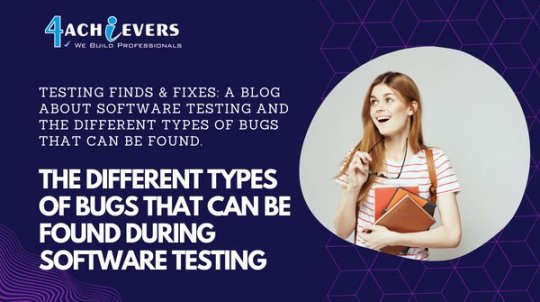
What are some common software bugs?
There are many different types of software bugs, but some are more common than others. Here are four of the most common types of software bugs: 1. Syntax errors 2. Runtime errors 3. Logical errors 4. Memory leaks Syntax errors are the most common type of software bug. They occur when the programmer makes a mistake in the code, such as forgetting to close a bracket or misplacing a semicolon. Runtime errors occur when the code is executed and something goes wrong, such as trying to access an array element that doesn't exist. Logical errors are mistakes in the logic of the code, such as an infinite loop that never ends. Memory leaks happen when the code fails to release memory that it no longer needs, eventually leading to a crash.
How can I prevent software bugs?
"Preventing software bugs is a difficult task because there are many potential causes of bugs. However, there are some steps that can be taken to reduce the likelihood of bugs appearing in your software. One way to prevent bugs is to use static code analysis tools. These tools analyze your code for potential errors and can help you find and fix them before they cause problems. Another way to reduce the number of bugs in your software is to use test-driven development. This approach focuses on writing tests for your code before you write the code itself. This can help you find and fix errors early on, before they cause problems."
Conclusion
We hope that this blog has helped you learn more about software testing and the different types of bugs that can be found. We know that it can be overwhelming to try to find and fix all the bugs in your software, but we believe that with the right tools and strategies, it is possible. Keep these tips in mind next time you're testing your software, and we think you'll be able to find and fix more bugs than ever before.
#softwaretesting #manualtesting #sdet #functionaltesting #programming #whatissoftwaretesting #automation #testing tools #testing #postman #bigdatatesting #etltesting #softwaretestingmaterial #softwaretestingtutorial #softwaretestingtraining #webservices #soapui #rest assured #hadooptesting #integrationtesting #software #manualtestingtutorial #softwaretestingtutorialforbeginnersseleniumvideos #performancetesting #automation testing #regressiontesting #softwaretestingforbeginners #softwaretestingtypes #testingtutorial #softwaretesting lifecycle #careerinsoftwaretesting #automationvidios #jmeter
0 notes
Text

#datascience#datascientist#datasciencecareer#machinelearning#futureofdatascience#datasciencejobs#dataanalytics#datasciencefuturescope#datasciencecareeropportunities#datascientistsalary#bigdata#data#datasciencescopeinfuture#datasciencefuture#futurescopeofdatascience#artificialintelligence#datasciencejobsin2020#datascienceskillsrequired#datasciencescopeinindia#datasciencescopeandsalary#datascience2020#pythondatascience#datasciencetraining#datascienceforbeginners#datascientistcareerdatasciencecareeroutlook#datasciencefuturescopeinindia#datasciencescopeincanada#datasciencetrends2020#datasciencesalary2020#edureka
0 notes
Text

#datascience#datascientist#datasciencecareer#machinelearning#futureofdatascience#datasciencejobs#dataanalytics#datasciencefuturescope#datasciencecareeropportunities#datascientistsalary#bigdata#data#datasciencescopeinfuture#datasciencefuture#futurescopeofdatascience#artificialintelligence#datasciencejobsin2020#datascienceskillsrequired#datasciencescopeinindia#datasciencescopeandsalary#datascience2020#pythondatascience#datasciencetraining#datascienceforbeginners#datascientistcareerdatasciencecareeroutlook#datasciencefuturescopeinindia#datasciencescopeincanada#datasciencetrends2020#datasciencesalary2020#edureka
0 notes
Text

#datascience#datascientist#datasciencecareer#machinelearning#futureofdatascience#datasciencejobs#dataanalytics#datasciencefuturescope#datasciencecareeropportunities#datascientistsalary#bigdata#data#datasciencescopeinfuture#datasciencefuture#futurescopeofdatascience#artificialintelligence#datasciencejobsin2020#datascienceskillsrequired#datasciencescopeinindia#datasciencescopeandsalary#datascience2020#pythondatascience#datasciencetraining#datascienceforbeginners#datascientistcareerdatasciencecareeroutlook#datasciencefuturescopeinindia#datasciencescopeincanada#datasciencetrends2020#datasciencesalary2020#edureka
0 notes
Text

#datascience#datascientist#datasciencecareer#machinelearning#futureofdatascience#datasciencejobs#dataanalytics#datasciencefuturescope#datasciencecareeropportunities#datascientistsalary#bigdata#data#datasciencescopeinfuture#datasciencefuture#futurescopeofdatascience#artificialintelligence#datasciencejobsin2020#datascienceskillsrequired#datasciencescopeinindia#datasciencescopeandsalary#datascience2020#pythondatascience#datasciencetraining#datascienceforbeginners#datascientistcareerdatasciencecareeroutlook#datasciencefuturescopeinindia#datasciencescopeincanada#datasciencetrends2020#datasciencesalary2020#edureka
0 notes
Text
10 Steps of Getting Job in Data Science
10 Steps of Getting Job in Data Science
Introduction
Data science is one of the most in-demand fields today. With the vast amount of data being generated every day, businesses need people who can help them make sense of it all. If you’re looking to get a job in data science, here are 10 steps you can follow to increase your chances of success.

What does a data scientist do?
A data scientist is responsible for extracting insights from data using various scientific methods. They use their skills in statistics, mathematics, and computer science to develop algorithms that can analyze data sets and make predictions. Data scientists also work on developing new ways to collect data, such as through sensors and social media. In addition to their technical skills, data scientists must also be able to effectively communicate their findings to non-technical audiences.
What skills are required to be a data scientist?
There is no one-size-fits-all answer to this question, as the skills required to be a data scientist will vary depending on the specific role and organisation. However, there are some key skills that are essential for all data scientists. Firstly, they must have strong analytical and mathematical skills, as they will need to be able to analyse complex data sets and draw conclusions from them. Secondly, they must be able to use various statistical software packages effectively, as this is often used to manipulate and visualise data. Finally, they should have excellent communication and presentation skills, as they will need to be able to explain their findings to non-technical staff and clients.
Where can I learn these skills?
There are a few ways that you can learn the skills necessary to get a job in data science. One way is to take online courses. These can be found through websites like Coursera and Udacity. Another way is to attend bootcamps or workshops offered by companies like Dataquest. Finally, you can also self-teach by reading books and articles, watching videos, and practicing on your own with datasets.
Which industries are data science applicable to?
Data science is applicable to a variety of industries, including healthcare, finance, manufacturing, retail, and more. In each of these industries, data science can be used to improve decision-making, optimize processes, and gain insights into customer behavior. Healthcare: Data science can be used to improve patient care by identifying patterns in health data. This information can be used to develop new treatments or target interventions to specific groups of patients. Finance: Data science can be used to identify trends in financial data and make predictions about future market movements. This information can be used by traders to make better decisions about when to buy or sell stocks. Manufacturing: Data science can be used to optimize production processes and reduce waste. This information can help manufacturers save money and increase efficiency. Retail: Data science can be used to understand customer behavior and preferences. This information can be used by retailers to design better marketing campaigns and stock their shelves with products that customers are more likely to buy.
Data science job titles
There are a number of data science job titles that you can pursue. Here are some of the most popular options: Data Scientist: A data scientist is responsible for extracting insights from data using statistical methods and analytical tools. They develop models to make predictions and recommend solutions to business problems. Data Analyst: A data analyst interprets data and turns it into meaningful information that can be used to improve decision making. They use statistical techniques and tools to analyze trends and patterns. Business Intelligence Analyst: A business intelligence analyst uses data to help organizations make better decisions. They develop reports, dashboards, and visualizations to help users understand complex data sets. Big Data Engineer: A big data engineer designs, builds, and maintains large-scale data processing systems. They work with big data technologies such as Hadoop and Spark to process huge amounts of data. These are just a few of the many possible job titles in the field of data science. To learn more about these positions and others, check out our complete guide to data science jobs.

How to prepare for a data science interview?
1. Know the basics: In order to prepare for a data science interview, you should first brush up on the basics. This means knowing the fundamental concepts and techniques in data science, as well as having a strong foundation in mathematics and statistics. 2. Study common interview questions: Another key part of preparing for a data science interview is to study common interview questions. This way, you will know what to expect and can better formulate your answers. 3. Practice with mock interviews: In addition to studying common interview questions, it is also helpful to practice with mock interviews. This will give you a chance to get comfortable with the interviewing process and help you hone your skills.
What are the salary and career prospects for data scientists?
There are many factors to consider when thinking about the salary and career prospects for data scientists. Here are a few key things to keep in mind: -The median salary for data scientists is $120,000 per year, with the top 10% earning more than $165,000 per year. -Career prospects are excellent for data scientists, with many companies willing to pay top dollar for talent in this field. -Data scientists with experience in specific industries (such as healthcare or finance) may be able to command even higher salaries. Overall, the salary and career prospects for data scientists are very strong. If you have the skills and experience needed to succeed in this field, you can expect to be handsomely rewarded for your efforts.
10 steps of getting a job in data science
There are a few key steps to getting a job in data science. First, it is important to have a strong foundation in mathematics and statistics. A bachelor's degree in one of these fields is usually required. Second, employers will want to see that you have experience working with data. This could include taking courses or completing internships in data-heavy fields such as finance or healthcare. Finally, it is essential to be proficient in at least one programming language and one statistical software package. R and Python are two popular choices. With these skills, you will be able to tackle even the most complex data sets.
What is data science?
Data science is an interdisciplinary field that uses scientific methods, processes, algorithms and systems to extract knowledge and insights from data in various forms, both structured and unstructured, similar to data mining. A data scientist is a person who is better at statistics than any software engineer and better at software engineering than any statistician. — Josh Wills, Director of Data Engineering at Cloudera Data science is a "concept to unify statistics, data analysis and their related methods" in order to "understand and analyze actual phenomena" with data. It employs techniques and theories drawn from many fields within the broad areas of mathematics, statistics, information science, computer science, computational science,[1][2] and decision science.[3] In business, data science is used to gain insights into customer behavior in order to make better decisions about marketing, product development, pricing, etc. In government organizations, data science is used to combat fraud, waste and abuse. And in the non-profit sector, data science is used to track social media sentiment around issues or brands. There are four main steps in becoming a data scientist: 1) Get a degree in an appropriate field such as computer science or mathematics; 2) Learn the basics of statistical analysis and machine learning; 3) Understand big data concepts and technologies; 4) Gain experience working with large datasets.

The skills you need for data science
There are many skills that you need for data science, but the most important ones are: -Programming: You need to be able to code in at least one programming language, preferably Python or R. -Statistics and mathematics: A strong understanding of statistics and mathematics is essential for data science. -Machine learning: Machine learning is a key part of data science, so you need to be familiar with different algorithms and how to implement them. -Data visualization: Data visualization is important for communicating your findings to others, so you need to be able to create clear and insightful graphs and charts.
The best places to find data science jobs
There are a number of great places to look for data science jobs. Here are some of the best: 1. Indeed - Indeed is a great place to start your job search. You can search by keyword and location to find data science jobs that match your criteria. 2. Dice - Dice is a job search engine that specializes in tech jobs. You can search for data science jobs on Dice by keyword and location. 3. LinkedIn - LinkedIn is a great place to network and find data science jobs. You can search for data science jobs on LinkedIn by keyword and location. 4. Glassdoor - Glassdoor is a job search engine that allows you to search by company, keyword, and location. This is a great way to find data science jobs at specific companies that you're interested in.
How to network for data science jobs
1. How to network for data science jobs As a data scientist, you will need to be well connected in order to find the best jobs. Here are some tips on how to network for data science jobs: - Attend industry events: There are many conferences and meetups specifically for data scientists. Attend these events to meet potential employers and other professionals in your field. - Get involved in online communities: There are numerous online forums and communities dedicated to data science. Getting involved in these communities will allow you to stay up-to-date on the latest job openings and also give you a chance to network with other professionals. - Use social media: LinkedIn is a great platform for networking, especially if you’re looking for jobs in data science. Follow companies and industry leaders that interest you, and make sure your profile is up-to-date so that potential employers can easily find you.
How to write a data science resume
A data science resume should highlight your strongest technical and analytical skills, as well as any relevant experience working with data. If you have little to no professional experience, you can still include coursework, research projects, and extracurricular activities that have helped you develop these skills. Here are some tips for writing a strong data science resume: 1. Start with a clear and concise summary of your professional experience and technical skills. 2. Include any relevant work experience, even if it is not directly in the field of data science. This could include roles in which you analyzed data or managed databases. 3. Highlight your educational background, especially if you have pursued coursework or research in data science or related fields. 4. List any significant awards or publications that showcase your work with data. 5. Finally, don’t forget to include important soft skills such as problem solving, critical thinking, and communication – all essential qualities for success in the field of data science!
How to ace a data science interview
Ace a data science interview by being able to speak to your experiences and projects you’ve undertaken. Be ready to discuss the technical aspects of data science, such as statistics, programming languages, and database management. In addition, be prepared to address the non-technical aspects of the role, such as communication and collaboration skills.

What are the different types of data science jobs?
Data science is a field of study that combines scientific methods, processes, and systems to extract knowledge or insights from data. It's a relatively new field that has emerged from the convergence of statistics, computer science, and information science. There are many different types of data science jobs, each with its own unique set of skills, responsibilities, and challenges. Here are some of the most common data science roles: 1. Data analyst: A data analyst is responsible for collecting, cleaning, and organizing data. They also use statistical techniques to analyze data and find trends or patterns. 2. Data engineer: A data engineer builds the infrastructure and tools that a data scientist needs to do their job. This includes developing algorithms, building databases, and creating software platforms. 3. Machine learning engineer: A machine learning engineer develops algorithms that allow machines to learn from data without being explicitly programmed. This is a highly technical role that requires a deep understanding of both statistics and computer science. 4. Business intelligence analyst: A business intelligence analyst uses data to help organizations make better decisions. They develop reports and dashboards to help managers understand what is happening in their business. 5. Product manager: A product manager uses data to inform decisions about what features to build or how to improve an existing product. They work with engineering, design, and marketing teams to ensure that the product meets the needs of customers
The salary of a data scientist
A data scientist's salary is usually very high. In order to get a job in data science, one must be able to show their worth to a company. A data scientist's responsibilities may include but are not limited to: collecting and analyzing data, developing models and algorithms, building prototypes, and collaborating with other scientists and engineers. The average salary for a data scientist is $115,000 per year.
Conclusion
Landing a job in data science can be a daunting task, but it is definitely possible with the right amount of effort and preparation. In this article, we have outlined 10 steps that you can take to increase your chances of getting a job in data science. While some of these steps may seem obvious, they are all important factors to consider when applying for jobs in this field. By following these tips, you will be well on your way to impressing potential employers and landing the job of your dreams.
#datascience #datascientist #datasciencecareer #machinelearning #futureofdatascience #datasciencejobs #dataanalytics #datasciencefuturescope #datasciencecareeropportunities #datascientistsalary #bigdata #data #datasciencescopeinfuture #datasciencefuture #futurescopeofdatascience #artificialintelligence #datasciencejobsin2020 #datascienceskillsrequired #datasciencescopeinindia #datasciencescopeandsalary #datascience2020 #pythondatascience #datasciencetraining #datascienceforbeginners #datascientistcareerdatasciencecareeroutlook #datasciencefuturescopeinindia #datasciencescopeincanada #datasciencetrends2020 #datasciencesalary2020 #edureka #futureofdatasciencejobs #datasciencecareerpath #dataanalyst #whatisatasience #datascientistjob
0 notes
Text
The future of data science
Data science is an interdisciplinary field that uses scientific methods, processes, algorithms and systems to extract knowledge and insights from data in various forms, both structured and unstructured.
Data science is a relatively new field, and as such, its future is hard to predict. However, there are a number of trends that suggest where the field may be headed.
#datascience#datascientist#datasciencecareer#machinelearning#futureofdatascience#datasciencejobs#dataanalytics#datasciencefuturescope#datasciencecareeropportunities#datascientistsalary#bigdata#data#datasciencescopeinfuture#datasciencefuture#futurescopeofdatascience#artificialintelligence#datasciencejobsin2020#datascienceskillsrequired#datasciencescopeinindia#datasciencescopeandsalary#datascience2020#pythondatascience#datasciencetraining#datascienceforbeginners#datascientistcareerdatasciencecareeroutlook#datasciencefuturescopeinindia#datasciencescopeincanada#datasciencetrends2020#datasciencesalary2020#edureka
0 notes
Text
#datascience#datascientist#datasciencecareer#machinelearning#futureofdatascience#datasciencejobs#dataanalytics#datasciencefuturescope#datasciencecareeropportunities#datascientistsalary#bigdata#data#datasciencescopeinfuture#datasciencefuture#futurescopeofdatascience#artificialintelligence#datasciencejobsin2020#datascienceskillsrequired#datasciencescopeinindia#datasciencescopeandsalary#datascience2020#pythondatascience#datasciencetraining#datascienceforbeginners#datascientistcareerdatasciencecareeroutlook#datasciencefuturescopeinindia#datasciencescopeincanada#datasciencetrends2020#datasciencesalary2020#edureka
0 notes
Text

#datascience#datascientist#datasciencecareer#machinelearning#futureofdatascience#datasciencejobs#dataanalytics#datasciencefuturescope#datasciencecareeropportunities#datascientistsalary#bigdata#data#datasciencescopeinfuture#datasciencefuture#futurescopeofdatascience#artificialintelligence#datasciencejobsin2020#datascienceskillsrequired#datasciencescopeinindia#datasciencescopeandsalary#datascience2020#pythondatascience#datasciencetraining#datascienceforbeginners#datascientistcareerdatasciencecareeroutlook#datasciencefuturescopeinindia#datasciencescopeincanada#datasciencetrends2020#datasciencesalary2020#edureka
0 notes